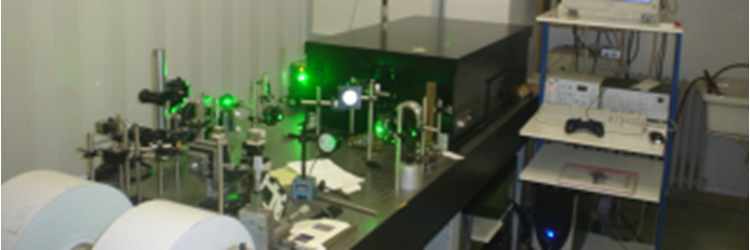

The Magnonics group of Perugia investigates the magnetization dynamics of low dimensional magnetic systems through Brillouin light scattering spectroscopy and microscopy. The main topics are magnonics crystals and control of spin wave propagation at the nanoscale.
The Laboratory comprises two optical tables to perform conventional and micro-focused Brillouin light scattering (BLS) measurements. In the conventional BLS apparatus a laser beam from a solid-state laser (532-nm line) is focused onto the sample surface using a camera objective of numerical aperture 2 and focal length 50 mm. The backscattered light was analyzed by a Sandercock-type (3+3)-pass tandem Fabry-Pérot interferometer. BLS measurements of the spin-wave frequency, can be performed as a function of the intensity of the applied magnetic field H up to 1T, the incidence angle of light, and the in-plane direction of H, with a spatial resolution of about 30 mm, determined by the diameter of the laser spot. The micro-focused BLS apparatus is characterized by a spatial resolution of about 250 nm. The light source is a single-frequency, Diode-Pumped Solid-State laser (532-nm line). A dark-field objective, with numerical aperture NA=0.75 and long working distance 4.7 mm, focuses light perpendicularly on the sample surface. Using the same objective, a coaxial viewing system based on a collimated LED light source, a beam expander, and a CCD camera is used to visualize the laser spot and the sample region under investigation. The sample holder is controlled by a software which provides an active stabilization of the lateral and vertical position of the sample by compensating for position drifts. Microwave generator (frequency range 250 kHz - 20 GHz) and three-axes positioning stages of pico-probes can also be used for the rf-excited spin-wave experiments.
The IOM researchers working at the Perugia unit conduct their activity for investigating magnetization dynamics of low dimensional magnetic systems such as, thin film, multilayers and patterned structures through Brillouin light scattering (BLS) spectroscopy and microscopy. The main topics which have been addressed in recent years are: magnonics crystals and control of spin wave propagation at the nanoscale.
Similar to photonic crystals, the spectrum of spin excitations in materials with periodically modulated properties shows bands of allowed magnonic states, alternating with forbidden band gaps. This constitutes a new class of artificial crystals, now known as magnonic crystals (MCs), where collective spin excitations rather than light are used to transmit and process information. The IOM researchers studied different kind of planar and layers MCs formed by arrays of magnetic elements coupled by dynamic dipolar interaction or single- and bi-component antidot lattices.
Very recently, a new class of MCs constituted by closely packed thickness-modulated Permalloy, Fe/Permalloy and Fe/Cu/Permalloy nanowires, has been proposed. We show that this kind of structures support the propagation of collective SWs in the periodicity direction, thus demonstrating that layering structure and in-plane modulation are very effective for controlling the characteristics of the magnonic band in a reprogrammable way. Finally, we started to explore 3D systems consisting in periodic meander-shaped ferromagnetic films and vertically coupled structures.
A very promising alternative to physical patterning is based on the use of hybrid heterostructures in the form of bilayer systems, such as: metal-insulator (Ni and Co grating on YIG), metal-heavy metal (CoFeB on Pt), metal-antiferromagnet (CoFeB on IrMn), and metal-ferroelectric (CoFeB on BaTiO), where new properties of spin waves such as filtering, guiding and steering and indirect gap in the magnonic band structure, emerge from interaction between the continuous (flat) magnetic film, where spin waves propagate, and the non-magnetic component which induces periodic modulation of either the static or the dynamic internal magnetic field of the magnetic film itself.